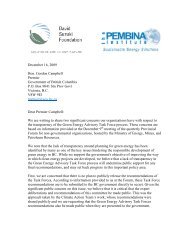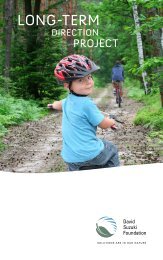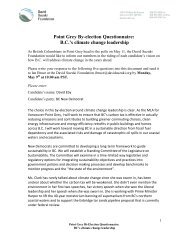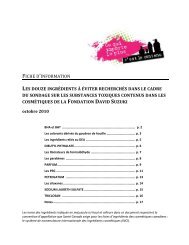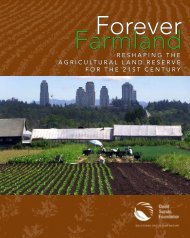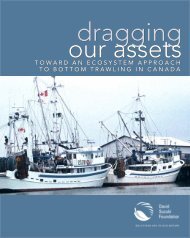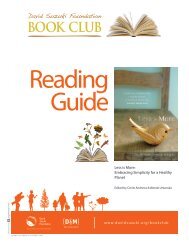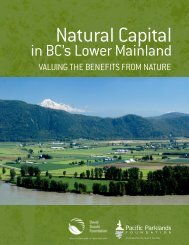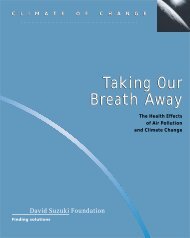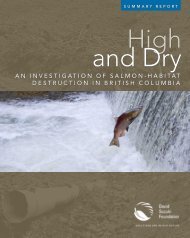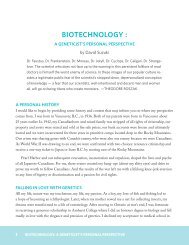On Thin Ice: Winter Sports and Climate Change - David Suzuki ...
On Thin Ice: Winter Sports and Climate Change - David Suzuki ...
On Thin Ice: Winter Sports and Climate Change - David Suzuki ...
Create successful ePaper yourself
Turn your PDF publications into a flip-book with our unique Google optimized e-Paper software.
new brunswick’s world<br />
pond hockey championship.<br />
with high-emissions future,<br />
global warming threatens<br />
to eliminate the majority of<br />
canada’s outdoor skating<br />
season, leaving the origin of<br />
our hockey culture on thin ice.<br />
photo: brian smith<br />
photographic<br />
photo: courtesy getty images<br />
16 exposure of winter sports to gloBal warMing<br />
country. This trend is particularly pronounced in Western Canada, which also experienced<br />
decreased snow coverage (based on satellite data) 73 <strong>and</strong> greater warming in winter during<br />
the same period. <strong>Ice</strong> on the lakes experiencing the most pronounced change is breaking<br />
up <strong>and</strong> melting about 10 to 15 days earlier than 30 years ago. 74 Another recent study using<br />
satellite data shows a similar two-week reduction in ice cover of Canadian lakes over the<br />
same period (50 years), but including both later freezing (six days later) <strong>and</strong> earlier melting<br />
(nine days earlier). 75 Based on the longest data record for lake ice in <strong>On</strong>tario, Lake Simcoe<br />
now freezes 13 days later than 140 years ago, <strong>and</strong> melts four days earlier. 76<br />
The safe winter use of frozen rivers <strong>and</strong> lakes for skating, hockey, snowmobiling, <strong>and</strong><br />
other recreational activities depends largely on ice thickness. For example, ice-fishing operators<br />
on Lake Simcoe in <strong>On</strong>tario generally consider 15 to 25 centimetres a safe ice thickness<br />
for placing fishing huts. 77 To date, there is insufficient data on the effect of global warming<br />
on maximum ice thickness of Canadian lakes <strong>and</strong> rivers, but climate models indicate that<br />
ice thickness is not just a consequence of temperature but is also significantly influenced<br />
by variation in the amount of snowfall 78 . This is because more snow cover provides a<br />
protective layer of insulation, shielding the ice during warmer weather days <strong>and</strong> reflecting<br />
sunlight. This allows the ice to remain cooler <strong>and</strong> thicken. With a general trend of decreasing<br />
snowfall predicted for Canada, lake <strong>and</strong> river ice may be more vulnerable to melting<br />
<strong>and</strong> may therefore not thicken to reliable levels for skating, pond hockey, ice fishing, <strong>and</strong><br />
other recreational uses.<br />
Scientists estimate that a long-term average increase of 2 to 3ºC in spring air temperature<br />
cuts the river-ice season in Canada by 10 to 15 days. 79 The most detailed research<br />
on the risk of global warming on ice staking in Canada was conducted for the Ottawa’s<br />
Rideau Canal Skateway – the world’s largest natural skating rink – using a high- <strong>and</strong> lowemissions<br />
scenario for the future (same scenarios as done for alpine skiing). The results<br />
are presented below.<br />
High-emission future puts pond hockey on thin ice, but low emissions<br />
can protect its future<br />
The study predicts that, under a high-emissions scenario, the Rideau Canal’s winter skating<br />
season, historically about 61 days long (nearly nine weeks), would shrink by 29 per cent<br />
(2.5 weeks) by 2020, <strong>and</strong> lose 67 per cent of its skating days (41 days) by 2050. Near the<br />
end of this century, the high-emission scenario would eliminate 87 per cent of the skating<br />
season, reducing it to just one week.<br />
“As hockey players, most of us grew up playing shinny on an outdoor rink.<br />
We know it’s important to protect winter so today’s kids don’t miss out on these<br />
experiences. We’re in a position to help raise awareness about climate change, <strong>and</strong><br />
the NHLPA Carbon Neutral Challenge shows that we all can make a difference.<br />
I’m doing my part to set a good example for my kids, while also hoping to inspire<br />
fans to take action in their own lives.”<br />
- Willie Mitchell, Vancouver Canucks defenseman



